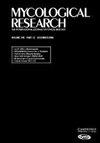Genetic diversity of Labyrinthula terrestris, a newly emergent plant pathogen, and the discovery of new Labyrinthulid organisms
Abstract
Labyrinthuloid organisms are thought almost exclusively to be only associated with marine environments. However in 1995, a disease of turfgrass suddenly appeared that was eventually determined to be caused by a new Labyrinthula species (Labyrinthula terrestris). The disease is primarily thought to be caused by the use of elevated salinity irrigation water, making it a unique example of an emergent plant disease potentially induced by human activity. Our objective was to examine diversity of L. terrestris from broadly distributed isolates using AFLP, sequence analysis of two rDNA loci (SSU & LSU-ITS), and pathogenicity tests since previous research on a limited number of isolates found no variability based in ITS and SSU. In contrast to previous work, 18 unique genotypes were found out of a total of 29 analyzed based on AFLP. Sequence variability was only found in a single pathogenic isolate (Laby 31) that was isolated from the United Kingdom. The divergence based on AFLP and sequence analysis suggests that this isolate is a distinct species but closely related to the other L. terrestris isolates examined. Two putatively new nonpathogenic Labyrinthulid species were also found (Laby 13 & 32). Our results suggest that these organisms may be widely distributed in terrestrial environments based on the diversity found in this study and may have long been associated with terrestrial plants. Our results also suggest that more Labyrinthulid organisms may potentially emerge as new plant pathogens in the future if salinification of agricultural systems continues to increases worldwide.

 求助内容:
求助内容: 应助结果提醒方式:
应助结果提醒方式:


